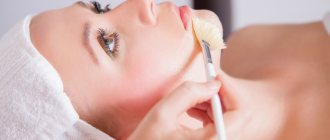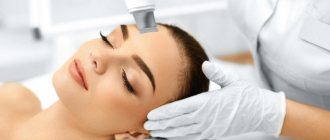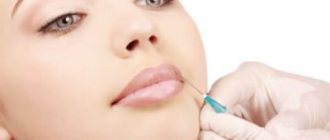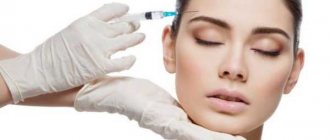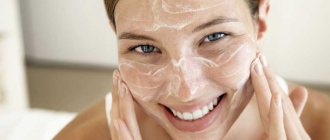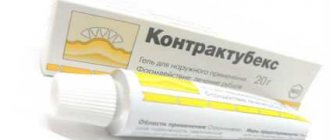Is it possible to enlarge lips while breastfeeding?
Only a few girls and women are satisfied with every detail of their appearance. The increased availability of plastic surgery allows them to adjust their appearance in ways that no cosmetics can, and the most popular procedure is lip augmentation. As for nursing mothers, they are usually wary of such an operation after hearing about hyaluronic acid, which in most cases is used for lip augmentation. Let's figure out whether this substance is dangerous for nursing mothers and whether there are alternative methods.
Hyaluronic acid: what it is and how it works
Hyaluronic acid is an absolutely natural compound for the body, synthesized by a group of so-called membrane proteins. There are approximately 15 grams of this substance in the body of a 70-kilogram person.
Among the functions of acid, three main ones can be distinguished:
- is one of the most important components of the synovial fluid that fills the joint cavities;
- maintains the elasticity of cartilage;
- participates in skin regeneration.
Based on the properties of hyaluronic acid, medicine began to use drugs based on it to treat cataracts, osteoarthritis and smooth out wrinkles, and cosmetology adopted this substance for the manufacture of creams, lotions and lipsticks.
Is it permissible to use hyaluronic acid during lactation?
This technique, called contouring, is based on the introduction of various fillers (fillers) made of collagen - also a natural component of the skin - and hyaluronic acid into the lips. The latter has the ability to hold a large volume of water, due to which the lips are given the desired size.
E-lactancia (a well-known online directory for checking drugs for compatibility with breastfeeding) indicates an extremely low risk of using acid for breastfeeding.
The reason for this is the very high molecular weight of the substance, which prevents its penetration into breast milk. Breastfeeding experts say the same thing.
Doctors working in the field of aesthetic medicine have a different point of view. Although the introduction of such a small amount of a substance “native” to the body cannot harm the mother’s health, cosmetic surgery specialists often refuse to give filler injections to nursing mothers. The reason lies not in the acid, but in the anesthetic, which is necessarily administered before injections. All anesthetics used (novocaine, ultracaine and lidocaine) are not recommended during breastfeeding, except in cases where it is impossible to do without them - for example, toothache.
The use of fillers is far from the only method of lip augmentation. Also slightly less popular are:
- Thread lifting. Installation of self-absorbable caprolactone threads along the contour of the lips, which tighten them and form new fibrous tissue.
- Operation Bullhorn. Turning the border of the lips outward, as a result of which they become more voluminous.
- VY-plasty. A technique similar to the previous one, but involving incisions in the shape of the letters “V” and “Y”, which allows not only to enlarge the lips, but also to change their shape.
- Installation of silicone implants.
- Electroporation. A relatively new technology, which consists in introducing the same hyaluronic acid using a non-injection method using a special electrical device. Acid molecules penetrate the skin through the excretory ducts of the sweat glands. The effect of the procedure lasts from six months to a year, depending on the patient’s age and skin parameters.
However, the first four procedures require local or general anesthesia, which is again incompatible with breastfeeding. It is not entirely clear why electroporation cannot be used during pregnancy and breastfeeding, but the prohibition may be related to the operating characteristics of the device.
If a nursing mother does not want to wait for the end of lactation, you can resort to alternative methods of lip augmentation.
Methods of lip augmentation approved for nursing mothers
These include the following six methods:
- Lip massage. Least effective procedure. Even when a visible result is achieved, the effect does not last long. A more extreme version - vacuum lip augmentation by suction to the neck of a bottle or narrow glass - is completely traumatic, although it promises a strong but short-lived effect.
- Lip exercises. These include silent pronunciation of vowels, stretching out lips, exhaling air through a slit in the lips, etc. A safe but low-effective method, which also requires regular practice.
- Thermage. Heating of collagen fibers using high-frequency but low-power radio radiation. Suitable for mothers during breastfeeding, it does not require anesthesia, but the effect is hardly noticeable.
- Correct makeup. Visual enlargement of the lips is achieved by tracing their contour with a pencil.
- Lip tattoo. Allows you, firstly, to make them a little more magnificent, and secondly, to change their color and make them clearer. Due to unpleasant sensations, it is not recommended during pregnancy, but is quite safe during breastfeeding.
- Lipolifting. The essence of the method is to inject the patient with her own fat cells taken from the buttocks, thighs or abdomen. The fat is thoroughly cleaned and injected into the lips using a syringe. Lipolifting in the facial area does not even require local anesthesia, making it completely safe. The effect lasts up to 3 years.
The lip fillers based on hyaluronic acid, which are so popular today, do not in themselves pose any danger, but the procedure for their administration is preceded by local anesthesia, which is undesirable for nursing mothers. The “black list” also includes thread lifting, all types of lip surgery, installation of implants and electroporation. Procedures allowed during breastfeeding include massage and lip exercises, Thermage, visual lip augmentation with makeup, tattooing and the most effective method - lipolifting.
AmyMama.ru
Hyaluronic acid - contraindications
The question of preserving and prolonging youth worries every woman who has crossed the thirty-year threshold and notices age-related changes on her face. At this age, the production of natural hyaluronic acid in the skin, a substance that performs a number of important functions for maintaining normal skin condition, decreases. Namely, hyaluronic acid moisturizes and ensures fluid balance in the skin tissue, creating favorable conditions for the functioning and renewal of cells.
That is why one of the most effective anti-aging procedures is the subcutaneous injection of hyaluronic acid synthesized by artificial bioengineering (biorevitalization), which compensates for the deficiency of its own. As a result, skin cells are activated, begin to function in a “young” mode, skin renewal and regeneration, and collagen production are enhanced. The skin becomes tighter and healthier.
But can everyone undergo this procedure without fear of side effects and complications? Unfortunately, biorevitalization may not be indicated for all women. There are some restrictions that must be taken into account, otherwise you can get extremely undesirable consequences. There are contraindications to both the injection of hyaluronic acid for the face and laser biorevitalization.
Contraindications to hyaluronic acid injections
The invasive method of biorevitalization, which is based on the introduction of hyaluronic acid through injections, has mixed reviews and many contraindications. First of all, it should be noted that injections are a medical procedure, and if the technique is performed incorrectly and the rules of asepsis are not followed, the consequences can be quite serious. Therefore, this procedure cannot be carried out in institutions that do not have the appropriate license.
Contraindications to injection biorevitalization with hyaluronic acid are as follows:
- bleeding disorders;
- infectious diseases of various etiologies;
- pregnancy;
- breastfeeding period;
- inflammatory formations on the face;
- individual intolerance to the drugs used.
You should also consider the compatibility of injection biorevitalization with other cosmetic procedures. In particular, the time interval between the introduction of hyaluronic acid and procedures such as deep peeling or laser resurfacing should not be less than 10 to 14 days.
Contraindications to laser biorevitalization with hyaluronic acid
Laser biorevitalization is an atraumatic rejuvenation technique that involves applying hyaluronic acid and then exposing the skin to a laser beam. Due to the fact that the procedure is non-injection, the skin is not damaged, and the risk of infection and hematoma formation is eliminated. However, this technique also has contraindications:
- oncological diseases;
- systemic blood diseases;
- infectious diseases in the acute stage;
- inflammatory formations on the face;
- diabetes;
- taking anticoagulant drugs;
- presence of a pacemaker;
- pregnancy;
- breastfeeding period;
- individual intolerance to the drugs used.
Laser treatment on the eyelids and the thyroid gland is contraindicated.
Contraindications to taking hyaluronic acid capsules
As you know, hyaluronic acid is produced today as a dietary supplement in the form of capsules. Internal use of this substance helps improve not only the condition of the skin, but the functioning of the joints. You cannot take hyaluronic acid capsules in the following cases:
- pregnancy and lactation;
- cancer;
- individual intolerance.
Related articles:
| How to remove wrinkles between eyebrows? Was anti-wrinkle cream powerless against the deep crease between the eyebrows? Don’t be upset, a frown will make the wrinkle even deeper! We will tell you how you can get rid of this cosmetic defect without the help of a plastic surgeon. | There is probably no girl who has not at least once envied the owners of eternally young and delicate skin - Japanese women. The secret of their success turns out to be quite simple - Asahi's massage. It is a mixture of traditional massage techniques and manual therapy. |
| To be beautiful and attractive for as long as possible – isn’t this what every woman dreams of? Hardware cosmetology procedures come to our aid. We will tell you about one of them, developed not very long ago, which has an immediate effect. | Endoscopic face lifting Endoscopic lifting is a completely new method of lifting, which does not leave behind scars, since it is carried out using punctures that leave no marks. In this article, you will learn in what cases endoscopic forehead and eyebrow lifting is performed. |
WomanAdvice.ru
So is it possible or not?
Is it possible to do mesotherapy procedures while breastfeeding?
There have been no studies confirming the safety of the salon procedure for infants. Therefore, doctors advise against it in order to avoid unforeseen consequences. It is not recommended to give “beauty injections” or expose yourself to non-invasive treatments.
Potential risks are considered:
- Allergic reaction
Cocktails used in mesotherapy are not always prepared individually, taking into account the sensitivity of a particular patient to them. More often than not, they arrive at a beauty salon ready-made, sometimes in violation of the rules for compatibility of their ingredients.
Incompatibility of components can lead to both the neutralization of one by the other, and to the inversion of a substance, in which its beneficial properties can turn into their opposite.
- Intoxication of the child's body
It has been established that approximately a fifth of the administered drug passes into breast milk.
- Hormonal imbalance
After childbirth, the female body is “overloaded” with hormones. Because of this, many chemical processes occur differently in it. Even with the introduction of a composition of hyaluronic acid and vitamins, no one can guarantee the normal reaction of the body. Under the influence of altered hormonal status, the results of the procedure may not at all coincide with expectations.
- Instability of lactose formation
Stress from manipulation in the form of painful shock can “scare off” the process of milk synthesis. This is due to a violation of the secretion of biologically active substances responsible for the production of lactose. If the baby is not actively breastfeeding, he will remain hungry.
- Skin necrosis
This complication may occur due to medical error or negligence. Some cosmetologists do not burden themselves with establishing the state of the patient’s immune system before performing manipulations. With a weakened immune system, the introduction of an infection into the body can cause necrosis - the death of part of the skin.
Hyaluronic acid during pregnancy and breastfeeding - can it be injected?
A woman wants to be beautiful in any circumstances. Due to the spread and popularity of products with hyaluronic acid, women begin to use them quite early. Finding these drugs is not difficult: every beauty salon offers filler injections, mesotherapy procedures and more.
Moreover, it is necessary to inject hyaluronic acid more than once, but in courses to achieve a positive effect (approximately every six months or even more often).
The state when a woman is pregnant is a special condition, a period when a woman must take especially careful care of her health, because life is developing in her. But this does not mean that you can completely forget about yourself. Therefore, many ladies are wondering: is it possible to use hyaluronic acid during pregnancy? Today we will try to understand this difficult issue.
Area of application of hyaluronate
The extraordinary popularity of hyaluronic acid in cosmetic procedures is due to their high efficiency and wide spectrum of action. Hyaluronic acid may even notice plastic surgery.
Options for using hyaluronic acid:
- external application (cream, ointment, gel, etc.);
- injections (fillers) – preparations based on high molecular weight hyaluronic acid;
- tablets (dietary supplements).
During pregnancy, the female body undergoes changes, and they are not always positive. Especially, the interesting position is reflected in the appearance. The skin becomes dull, rashes and pigmentation appear. Dryness, irritation that was not there before. Hyalurnic acid is a way to get rid of such problems.
Effect of hyaluronic acid:
- the skin acquires a healthy shade and is moisturized;
- small wrinkles are smoothed out;
- large creases and scars are straightened out (it is necessary to take a course of injections);
- pigmentation decreases;
- regeneration accelerates.
Hyaluronic acid and pregnancy
It is logical that such almost magical properties of hyaluronic acid are very attractive. And do not forget that the acid that is used during injections is a synthesized substance, identical in composition to the acid produced by the human body.
Cosmetologists know this, so they allow their clients to receive hyaluronic acid injections during pregnancy. This is especially true for women who regularly receive hyaluronate injections. Sometimes ladies come to a beauty salon and ask to carry out the procedure themselves, despite their “interesting situation”, because if you interrupt the course of injections that you have started, the achieved effect will go away.
Most cosmetologists are convinced that hyaluronic acid during pregnancy is normal and cannot cause any harm to health. You can only “take care” in the first trimester, when the child’s organs are forming, and then there are no contraindications.
However, gynecologists categorically disagree with this opinion: they are convinced of the dangers of injections. The worst thing is that it is not clear how the pregnant woman’s body will react. It does not matter how the procedure was tolerated previously. Those who do not encourage hyaluronic acid injections for pregnant women (especially in the early stages) give the following arguments:
- During pregnancy, a real hormonal boom occurs. Any new substance is perceived differently. No one is immune from a possible allergic reaction, but in an “interesting situation” the risk of causing a severe allergic reaction (including angioedema and anaphylactic shock) increases significantly. In addition, the body will reject hyaluronic acid;
- hyaluronate injections are made into the tissue, very deep under the skin. Often, blood vessels are damaged when piercing. Under normal conditions, blood clots relatively quickly and the body copes with damage. During pregnancy, blood clotting may be impaired, and large bruises and stains form at the puncture site;
- During pregnancy, healing at injection sites can follow a completely different scenario. Consequently, the desire to get rid of external defects will lead to even more scars;
- an injection always causes tissue damage. Naturally, procedures for introducing hyalurnic acid are carried out in a cosmetologist’s office, in compliance with all disinfection rules, but the risk of any infection always remains. Under normal conditions, our body easily copes with germs and microorganisms that enter the body through a wound. But during pregnancy, the immune system weakens, and there is no longer much strength to fight, so in addition to beauty, it is possible to get an inflammatory reaction.
During pregnancy, you can inject hyaluronic acid only in one case: the gynecologist approved the procedure. It is very difficult to achieve this; you will have to give weighty arguments.
This approach of doctors is due to the fact that no one can say for sure: how the female body will behave. During pregnancy, restructuring occurs, the body changes, and along with it the reaction to various kinds of manipulation changes. No one will give an accurate forecast. It is possible that the consequences described above will not happen, or perhaps you will have to go to the hospital due to the threat of miscarriage or even harm the baby (the toxins contained in the acid can harm the baby’s cardiac system).
Other uses of hyaluronic acid
Hyaluronic acid can enter our body not only in the form of injections, but also through the skin. Cream with hyaluronic acid during pregnancy is a good replacement for injections, as it has no restrictions on its use. Creams have one significant drawback: their effectiveness is several times lower compared to injections.
The cream is made on the basis of high-molecular hyaluronic acid, the molecules of which are large and physically incapable of penetrating into the deep layers of the skin. Cream and other external products certainly have a positive effect, but it is not so pronounced and noticeable. Acid does not penetrate deep into the epidermis. You can expect that expression lines will become less pronounced and your skin will look healthier.
Oral medications (tablets and capsules) are another possible alternative to injections. The main problem here is that when hyaluronic acid enters the human body through the stomach, it first breaks down, then it is distributed by the blood to all organs. And it is unknown: exactly what part of the substance will end up in the dermis.
About the same effect can be achieved by slightly changing your diet. Hyaluronate is found in common foods: buckwheat, sweet potatoes and beets, grapes and natural grape juice, some legumes (beans and soybeans).
Lactation and hyaluronic acid
Previously, the attitude towards a nursing mother was special. Today, little has changed. Breastfeeding your baby is not only joy, but also a great responsibility.
Breastfeeding and hyaluronic acid are two incompatible things. Experts' verdict. First of all, because of the danger of causing an allergy in the child, since the acid that enters the mother’s body will certainly be passed on to the newborn.
When planning a pregnancy, it is better to avoid cosmetic procedures with hyaluronate altogether. It is better to interrupt your transformation for a while for the sake of the health of your unborn child.
Video
cosmetologo.ru
What about dietary supplements and creams?
Cream with hyaluronic acid during pregnancy is no worse or better than other creams. Considering that the acid itself is safe and even healthy, you need to worry more about the other ingredients in the composition than about it. Of course, you shouldn’t count on a super effect: if creams could replace invasive cosmetology, no one would use it.
The situation with dietary supplements is similar. Surely on the jar you will find a warning that it is better to consult a specialist in advance: now we know that in the case of hyaluronic acid this is more of a warning than a contraindication. When taken orally, hyaluronic acid itself has virtually no effect on the condition of the skin (the body sends it to more needed places), but it perfectly compensates for its deficiency in joints and cartilage, which is also not bad.
It’s up to you to decide whether to buy creams, take dietary supplements and give injections. If you want to reinsure your baby, and you don’t want any unnecessary problems, it would be better to be patient. But if you can’t imagine life without injections, know: they are not so scary. If you approach the choice of drug wisely and are mentally prepared for pain and minor troubles in the form of swelling and bruises, you can take risks in agreement with a cosmetologist! In the end, for a child with a good drug, the risk from injections is minimal, and his development is much more influenced by the correct regime, nutrition and ecology. So you better think about it!
Are pregnancy and lactation contraindications to hyaluronic acid injections?
Have you been doing hyaluronic acid injections for quite some time and are not going to give up the procedure even while carrying a baby and breastfeeding? We understand that you don’t really want to know what your face will look like without beauty injections for a couple of years, but we still recommend that you read the information about how dangerous hyaluronic acid is during pregnancy.
Main risks
Not every cosmetologist will agree to perform the procedure on a pregnant or lactating woman, and the preparations themselves will most likely contain a warning that their use is a contraindication for this category of people. It is not surprising that girls are seized with panic: fears begin that the drugs may affect the development of the fetus, and even worries about procedures performed immediately before pregnancy. So where is the truth and what is worth fearing and what not?
Risks for the child
The biggest risk of such injections for a baby is the development of a severe allergic reaction to hyaluronic acid. Not only will you no longer be able to use the same drug even after pregnancy and breastfeeding, but such an allergy can be passed on to the child, whose development is affected by everything that happens to the mother during pregnancy. And if you think: “I’ve been injecting this drug for a thousand years, nothing will happen if I don’t change it,” then we will have to disappoint you. Due to dramatic changes in hormonal levels during this period, allergies can appear even to those substances that your body has accepted normally for many years.
Advice
Many cosmetologists believe that using hyaluronic acid in the second trimester is much safer than in the first.
That's essentially all. Seriously. Hyaluronic acid cannot greatly harm a developing fetus or an already born baby through milk, so in this regard, injections with it are less harmful than bad food, polluted air in a metropolis, alcohol and smoking.
Risks for women
Why does a cosmetologist refuse to see you? This has less to do with concerns about your baby and more to do with your body's reaction to the procedure. If this is not your first time getting injections, then you probably know that even during menstruation, the procedure is carried out reluctantly. Just because of changes in hormonal levels! And during menstruation they are incommensurate with what happens during pregnancy and breastfeeding.
What can your impatience cost?
- The worst thing is allergies, which we have already mentioned. It happens less often than you might now think, but the problem is that there is no way to predict the reaction.
- The second most unpleasant thing is an effect that does not meet expectations. Due to the same hormones, tissues may not accept hyaluronic acid as usual, and it will be absorbed as luck would have it. This can cause asymmetry, which you won't like very much if you're doing lips, or bumps that look even worse than the wrinkles themselves. Add to this the cases when the hyaluronic acid dissolves not after six months or a year, but after a couple of months, and think twice before spending money.
Important!
If you took injections during your first pregnancy and everything was fine, this does not mean that everything will be the same during your second pregnancy. Pregnancies go differently for one woman, and this is no secret, so you shouldn’t relax.
- Another disadvantage of such procedures is pain and long recovery, which occurs due to the influence of hormones on blood clotting and pain threshold. On the one hand, pain, swelling and bruises can be endured, but on the other hand, such a procedure will be stressful for the body, and any stress during pregnancy indirectly affects the baby.
- You can also think about this: your body’s immunity is weakened, so the risk of getting an infection even with the “direct hands” of a cosmetologist increases greatly. Is it worth torturing an already weakened body?
Is hyaluronic acid dangerous when breastfeeding? It is still not recommended to do it due to hormonal changes, but the risks remain the same. Of course, everyone’s body is unique, and some will experience these effects of hyaluronic acid, while others will not. But is it worth the risk?
Why hyaluronic acid is safer than it might seem
Don't the risks seem so scary to you? Of course, hyaluronic acid is already contained in your body, so it would be strange to fear mutations or defects. This is not Botox, which is essentially poison: its contraindication during pregnancy is much more justified! It is hyaluronic acid, along with collagen and elastane, that is responsible for skin elasticity, as well as the health of joints, cartilage and ligaments.
Yes, synthesized hyaluronate is used to create preparations, but with high-quality cleaning it does not cause allergies and is absolutely safe. That is why, when deciding on the procedure, you need to take a responsible approach to choosing a filler. Not only cleaning is important here, but also the presence of accompanying components: in most cases they are the culprits of allergies.
By the way
Additional substances in preparations based on hyaluronic acid may not be as safe as the hyaluronic acid itself. They are unlikely to cause much harm, but they can slightly worsen the overall background for the baby’s development.
But since hyaluronic acid is relatively safe, why are cosmetologists and manufacturers so categorical about their prohibitions? The fact is that due to hormonal imbalances, no one can predict your body’s reaction to the procedure and everyone wants to protect themselves. What if an allergy manifests itself in your case and you decide to go to court? And this applies to any drugs and manipulations in the medical or near-medical field. Any pill will say, if not “contraindicated during pregnancy,” then “consult your doctor if pregnant,” for sure!
It turns out that there are different contraindications to contraindications, and hyaluronic acid during pregnancy is certainly not comparable to taking dangerous medications.
What about dietary supplements and creams?
Cream with hyaluronic acid during pregnancy is no worse or better than other creams. Considering that the acid itself is safe and even healthy, you need to worry more about the other ingredients in the composition than about it. Of course, you shouldn’t count on a super effect: if creams could replace invasive cosmetology, no one would use it.
The situation with dietary supplements is similar. Surely on the jar you will find a warning that it is better to consult a specialist in advance: now we know that in the case of hyaluronic acid this is more of a warning than a contraindication. When taken orally, hyaluronic acid itself has virtually no effect on the condition of the skin (the body sends it to more needed places), but it perfectly compensates for its deficiency in joints and cartilage, which is also not bad.
It’s up to you to decide whether to buy creams, take dietary supplements and give injections. If you want to reinsure your baby, and you don’t want any unnecessary problems, it would be better to be patient. But if you can’t imagine life without injections, know: they are not so scary. If you approach the choice of drug wisely and are mentally prepared for pain and minor troubles in the form of swelling and bruises, you can take risks in agreement with a cosmetologist! In the end, for a child with a good drug, the risk from injections is minimal, and his development is much more influenced by the correct regime, nutrition and ecology. So you better think about it!
By secret
- You missed the meeting of your classmates because you are afraid to hear that you have grown old...
- And you catch the admiring glances of men less and less...
- Advertised skin care products do not freshen the face as much as they used to...
- And the reflection in the mirror increasingly reminds us of age...
- Do you think you look older than your age...
- Or you just want to “preserve” your youth for many years...
- You desperately don't want to grow old and are ready to use every opportunity to do so...
Just yesterday no one had a chance to regain youth without plastic surgery, but today it has appeared!
Follow the link and find out how you managed to stop old age and restore youth
SecretFace.ru
Biorevitalization is indeed tolerated differently by everyone. But why is that?
How successful the procedure will be depends on several factors, including:
- Qualification of a cosmetologist who gives injections. Bruises, swelling - all this, as a rule, is the work of a non-professional.
- Misinformation from the client. Many people hide the peculiarities of their body’s functioning from cosmetologists, wanting to rejuvenate in the shortest possible period of time. But the doctor must find out about contraindications, otherwise the results can be very disastrous.
Many rely on information received from friends, according to which someone did biorevitalization while breastfeeding, and subsequently everything was fine with him (as well as with his child). But such reviews should be treated with caution, since everyone’s body is different.
Thus, before going to the OB clinic salon, you must definitely consult with specialists and, if possible, postpone the procedure to a later period. Moreover, in some cases there is no positive effect from the injections, and the young mother will only get stress in vain. Contour plastic surgery is also contraindicated during breastfeeding. Don't take risks and postpone the procedures.
The benefits and harms of hyaluronic acid for nursing mothers
The article describes not only the benefits and harms of hyaluronic acid for nursing mothers, but also how to use hyaluronic acid at home, whether it can be applied to the eyelids or added to creams. I use gel with hyaluronic acid.
Hyaluronic acid: benefits and harms, use at home
Nursing mothers should not forget about their appearance, but they should be very selective when buying cosmetics. Increasingly, jars of creams and hair balms from well-known brands bear the inscription: “with hyaluronic acid.” It is always worth remembering that any substance has both benefits and harm to the body. Before you blindly believe advertising and buy hyaluronic acid in capsules or creams with its additives, let's find out:
- What is hyaluronic acid
- The benefits and harms of hyaluronic acid
- Is it possible for nursing mothers to use hyaluronic acid gels and procedures with it?
- Which facial treatments with hyaluronic acid in capsules are suitable for nursing mothers
What is hyaluronic acid
If we explain everything at the school curriculum level, then the main component of the acid, hyaluronate, is a complex polysaccharide. This acid is part of us because it is found in nerve tissue. You should know that the benefits and harms of hyaluronic acid for humans are enormous and cannot be overestimated. Even in cartilage tissues it is necessary; a small amount is found in human saliva. As you can see, the older a person is, the higher his body’s need for hyaluronate. However, women are more concerned about its presence in connective tissues and epithelium, which makes the skin more elastic.
In a child's body, in the body of nursing mothers and pregnant women, the concentration of hyaluronic acid is in increased concentration, whereas in an ordinary adult weighing 70 kg, it can be up to 13-16 grams. Every day 5 grams of it disintegrate, and exactly the same amount appears...
The benefits and harms of hyaluronic acid for the body
This component is very actively involved in the movement of cells within our body. Scientists have discovered not only the positive effects of hyaluronic acid on the body, but also found disadvantages. It negatively affects the metabolism of the cell - leading to its intensive growth, active division (wrinkle filling effect), but what if these are cancer cells? The well-known bacteria streptococci are capable of reproducing hyaluronic acid. A clear example of the relationship in our body of something very useful and revolutionary with something negative.
What is hyaluronic acid responsible for in the body of nursing mothers?
First of all, hyaluronic acid is responsible for the regeneration of tissues of nursing mothers - the rate of division of new cells and wound healing. Hyaluron can be called the glue that connects skin fibers to each other. The more it is, the more elastic the skin. The concentration of this substance decreases with age, hence the loss of skin elasticity, deepening of wrinkles and slowly healing small wounds.
No wonder cosmetologists claim that a rich tan leads to skin aging. Under the sun, acid breaks down, and this leads to dehydration. Hyaluronic acid is found in all cells because it is a component of it. It has been noticed that in nursing mothers the problems of arthrosis and polyarthritis disappear (if they existed before pregnancy, this often applies to former athletes).
Its molecule is so large that it can bind almost a thousand water molecules (imagine the size of hydration). However, its size is so large that it hardly penetrates the skin molecules, getting stuck in the upper layers of the epidermis. It is like a washcloth, absorbing moisture and holding it for a long time. Naturally, these properties simply must be used both in medicine and in cosmetology. Therefore, hyaluronic acid is produced not only in gels for cosmetic purposes, but also in tablets. Hyaluronic acid is vital for the body of nursing mothers, since some of the liquid is lost with milk, and some nursing mothers consume very little liquid, which is why wrinkles appear sharply (and we attribute this to lack of sleep) and the skin on the elbows and knees becomes dry.
Medical benefits of hyaluronic acid
These drugs are used if you need to urgently combat dehydration. In case of severe painful shock, it promotes the fastest delivery of pain-relieving components into the body. And in ophthalmology it is successfully used to treat cataracts.
Hyaluronic acid: how to use at home
What facial procedures with hyaluronic acid are suitable for nursing mothers and can nursing mothers use hyaluronic acid gels and procedures with it?
The opinions of cosmetologists differ
- According to some nursing mothers, gels with hyaluronic acid can be used only in extreme cases with extreme caution, and not in their pure form, but as a kind of additive (conductor).
We come to the question of how many people are interested in hyaluronic acid itself and how to use it at home.
- If a nursing mother rubs vitamins into her hair (and she and the baby do not experience allergic reactions), then a FEW DROPS of hyaluronic acid in the form of a gel can be added to the vitamins. It is recommended to add a couple of drops of gel to the cream once a week, as the most gentle and non-allergenic method. At the same time, if you buy a ready-made cream containing this component, no one can guarantee that it is not a fake, and that it is actually present there. In the photo, I deliberately shaded out the name of the cosmetic company. It is better to buy a simpler cream and “enrich” it yourself with the necessary components, purchased at the pharmacy.
- Personally, I am already using my second bottle of this wonderful substance in the form of a gel. Having dry hair after numerous dyes, I add a few drops of it to oily vitamin E or A, just before applying it to the roots (ends) of the hair.
- I tried to apply hyaluronic acid in capsules to the skin of the face; the effect was noticeable after 3-4 days, especially on the nasolabial folds and in the corners of the eyes. The mood immediately lifts!!!!! However, my skin began to itch (maybe not because of it), but because it was winter and the air became drier, and I returned to the method of adding hyaluronic acid to creams before applying to the skin.
photo of a cream with hyaluronic acid
Subcutaneous injections with it are possible for nursing mothers only after consultation with an experienced cosmetologist, and only in the case of long-term feeding (after a year, when there is already complementary feeding). A similar measure is taken in case of an allergic reaction, not in the nursing mother, but in her baby. After breastfeeding for a long time, a woman can interrupt breastfeeding at any time, without harm to her baby.
- Other experts find clear signs of dehydration in nursing mothers (dry skin, hair). They recommend immediately filling it with vitamins and microelements, using galvanic procedures for electrical conductivity of vitamins, moisturizing hyaluronic acid and other components. Non-injection (oxygen) biorevitalization is recommended, or more precisely, a hardware procedure for introducing hyaluronic acid into the epidermis of the skin.
- Mothers who are not breastfeeding can, and sometimes should, apply a few drops of hyaluronic acid in capsules to the area under the eyes and nasolabial folds.
Author of the text: Natalya Chalaya.
3karapuzika.ru

